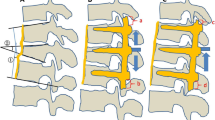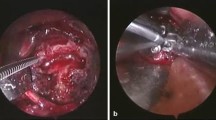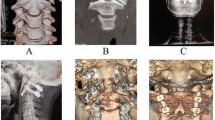Abstract
Introduction
The unstable atlas burst fracture (“Jefferson fracture”) is a fracture of the anterior and posterior atlantal arch with rupture of the transverse atlantal ligament and an incongruence of the atlanto-occipital and the atlanto-axial joint facets. The posterior atlantoaxial fusion is frequently used to reconstruct the stability of atlantoaxial joint. Conventional posterior atlantoaxial fixations are associated with high rates of pseudoarthrosis and chronic atlantoaxial instability. As a modified three-point fixation the bilateral C1-2 transarticular screws combined with C1 laminar hook and bone grafts can provide best biomechanical stability, but no standard protocol has been reported for the use of this fusion technique. A retrospective review of clinical series should be conducted to evaluate the clinical outcome of bilateral atlas laminar hook combined with transarticular screw fixation for unstable bursting atlantal fracture.
Materials and methods
From March 2002 to March 2006, there were total 12 cases of unstable atlantal bursting fractures, 10 males and 2 females, age ranging 18–54, with mean of 36 years old. All patients were operated on posterior atlantoaxial fusion using bilateral atlas laminar hook combined with transarticular screw fixation after atlantoaxial joint were reduced and followed up for 12–24 months. The medical records and radiographs of the 12 patients were reviewed. Each patient underwent a complete cervical radiograph series including lateral flexion-extension view and a computed topographic scan. The Frankel grades and ASIA scores were applied to assess the neurologic status.
Results
In all patients, a good bony fusion of the atlanto-axial segment was achieved. All patients showed significant improvement of the neurologic defect and no instability on their follow-up plain radiographs and computerized tomography in follow-up interval.
Conclusions
For the patients who suffer from the unstable bursting atlantal fracture, the nonoperative methods could carry some clinical complications including infection, nerve injury, etc. and is frequently failure, Posterior atlantoaxial fusion using bilateral atlas laminar hook combined with transarticular screw fixation is an effective treatment.






Similar content being viewed by others
References
Botte MJ, Byrne TP, Abrams RA, Garfin SR (1995) The halo skeletal fixator: current concepts of application and maintenance. Orthopedics 18:463–471
Dai LY, Jia LS (1994) Radiographic measurement of the prevertebral soft tissue of the cervical vertebrace. Chin Med J 107:471–474
Deen HG, Tolchin S (1989) Combination Jefferson fracture of C1 and Type II odontoid fracture requiring surgery: Report of two cases. Neurosurgery 25:293–297. doi:10.1097/00006123-198908000-00023
Dickman CA, Crawford NR, Brantley AG et al (1995) Biomechanical effects of transoral odontoidectomy. Neurosurgery 36:1146–1152. doi:10.1097/00006123-199506000-00013
Dickman CA, Crawford NR, Paramore CG (1996) Biomechanical characteristics of C1–C2 cable fixations. J Neurosurg 85:316–322
Dickman CA, Greecne KA, Sonntag VKH (1996) Injuries involving the transverse atlantal ligament: classification and treatment guidelines based upon experience with 39 injuries. Neurosurgery 38:44–50. doi:10.1097/00006123-199601000-00012
Gehweiler JA, Daffner RH, Roberts L (1983) Malformations of the atlas vertebra simulating the Jefferson fracture. AJR Am J Roentgenol 140:1083–1086
Haus BM, Harris MB (2008) Case report: nonoperative treatment of an unstable Jefferson fracture using a cervical collar. Clin Orthop Relat Res 466:1257–1261. doi:10.1007/s11999-008-0143-5
Jackson RS, Banit DM, Rhyne AL 3rd et al (2002) Upper cervical spine injuries. J Am Acad Orthop Surg 10:271–280 Review
Kandziora F, Kerschbaumer F, Starker M et al (2000) Biomechanical assessment of transoral plate fixation for atlantoaxial instability. Spine 25:1555–1561. doi:10.1097/00007632-200006150-00016
Landels CD, Van Peteghem PK (1998) Fracture of the atlas: classification treatment and morbidity. Spine 13:450–452
Lee TT, Green BA, Petrin DR (1998) Treatment of stable burst fracture of the atlas (Jefferson fracture) with rigid cervical collar. Spine 23:1963–1967. doi:10.1097/00007632-199809150-00008
Levine AM, Edward CC (1989) Traumatic lesion of the occipitoatlantoaxial complex. Clin Orthop Relat Res 239:53–68
Ly JQ (2002) Jefferson fracture. J Emerg Med 23:415–416. doi:10.1016/S0736-4679(02)00580-2
Madawi AA, Casey AT, Solanki GA et al (1997) Radiological and anatomical evaluation of the atlantoxaxial transarticular screw fixation technique. J Neurosurg 86:961–968
Panjabi MM, Oda T, Crisco JJ 3rd et al (1991) Experimental study of atlas injuries I: biomechanical analysis of their mechanisms and fracture. Spine 16(Suppl 10):s460–s465. doi:10.1097/00007632-199104000-00013
Richter M, Schmidi R, Claes L et al (2002) Posterior atlantoaxial fixation: biomechanical in vitro comparison of six different techniques. Spine 27:1724–1732. doi:10.1097/00007632-200208150-00008
Robert HF Jr, Herbert K et al (2002) Orthopaedics. Mosby, Philadelphia, pp 861–893
Spence KF, Decker S, Sell K (1970) Bursting atlantal fracture associated with rupture of the transverse ligament. J Bone Joint Surg Am 52:543–549
Stillerman CB, Wilson JA (1993) Atlantoaxial stabilization with posterior transarticular screw fixation: technical description and report of 22 cases. Neurosurgery 32:948–954. doi:10.1097/00006123-199306000-00011
Tator CH (2005) Neurologic examination: grading scale. In: Clark CR (ed) The cercial spine, 4th edn. Lippincott Willianms & Wilkins, Philadelphia, pp 184–195
Author information
Authors and Affiliations
Corresponding author
Additional information
Xiang Guo and Bin Ni contributed equally to the article.
Rights and permissions
About this article
Cite this article
Guo, X., Ni, B., Wang, M. et al. Bilateral atlas laminar hook combined with transarticular screw fixation for an unstable bursting atlantal fracture. Arch Orthop Trauma Surg 129, 1203–1209 (2009). https://doi.org/10.1007/s00402-008-0706-7
Received:
Published:
Issue Date:
DOI: https://doi.org/10.1007/s00402-008-0706-7




